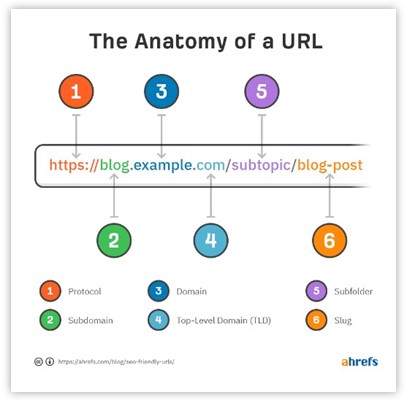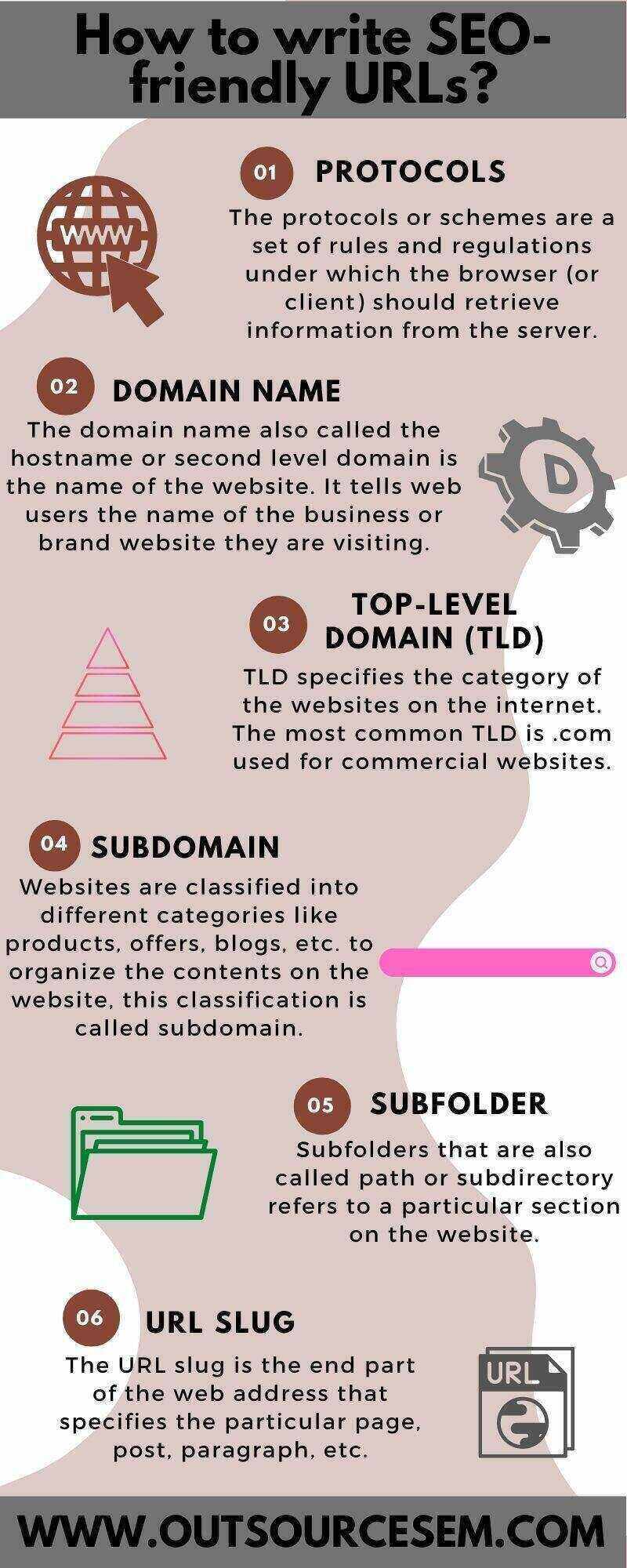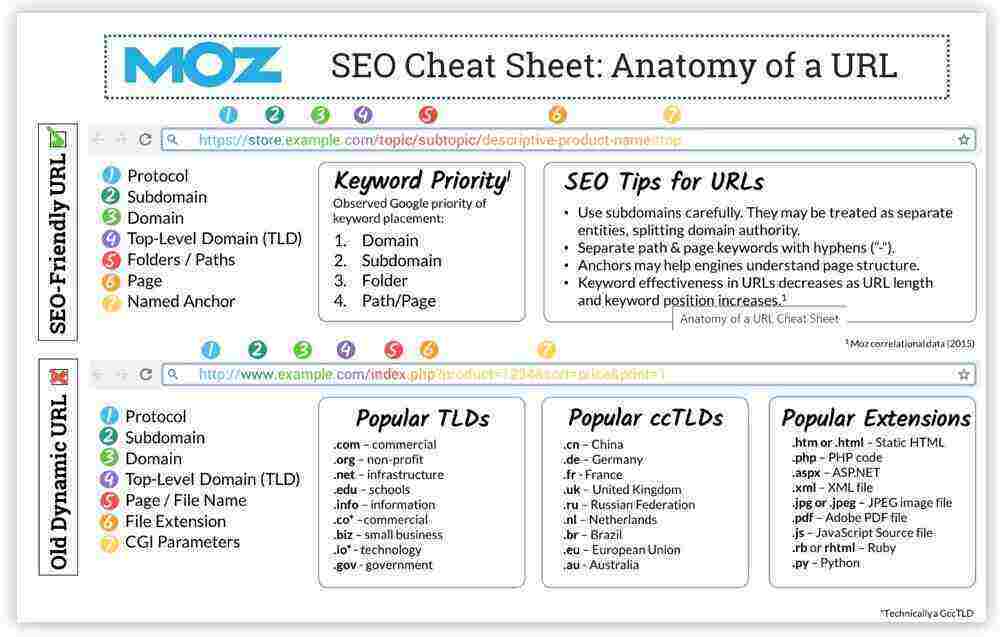While developing a website or creating a webpage, you have to be very careful that the content on the page is well written and optimized, headlines according to the SEO best practices, and everything on the page is according to the SEO guidelines. But have you ever thought about the URL of the page? Whether it needs optimization or not, it affects website ranking or not. After reading this blog, you must do it if you do not think about writing SEO-friendly URLs. URLs can improve the website ranking across search engine results pages. Many website developers focus on writing eye-catching headlines, titles, and meta tags but underestimate the importance of URLs. In this article, we’ll discuss URLs and their structure, the significance of URLs in SEO, SEO tips to write optimized URLs, and common mistakes that should be avoided to improve your on-page SEO performance.

URL: Definition
URL (Uniform Resource Locator), also known as a web address, is the address for the resources (website or webpage) across the internet. URLs are the readable texts that are used by computers to communicate with servers and call the resources required; a human user can also get information about the webpage by seeing the URL. The URL also specifies how to retrieve that resource with the help of protocols like HTTP (Hypertext Transfer Protocol), HTTPS (Hypertext Transfer Protocol Secure), FTP (File Transfer Protocol), etc.
URL structure
Before diving deeper into the details of how URLs are essential for search engine optimization and website ranking, first, let's understand the structure of the URLs with the help of an URL example.
protocol://domain-name.top-level-domain/path - this is the most basic format of the URL structure.
Above is an example of a simple URL that can be most commonly seen on the websites' homepages. It contains the protocol i.e. https, subdomain i.e www (World Wide Web), domain name i.e outsourcesem, and .com i.e TLD (Top level domain). Now, look at another URL example of a little complex URL.
https://www.outsourcesem.com/blog/why-refreshing-old-content-is-good-seo-measure.html
Here you can see some more elements in the URL after .com which are blog i.e. path or subfolder, why-refreshing-old-content-is-good-seo-measure i.e. slug, which is the crucial aspect of creating an SEO-friendly URL. With this URL structure, it is clear that a web address consists of protocols, domain names, and paths that have specific folders or subfolder structures where a resource is located on the internet. The below image from Ahrefs provides more clarity on the format of the URL. We will discuss all these URL parts and understand their significance in the website ranking.

Why do URLs matter in SEO?
An SEO-friendly URL is easy to understand and more interactive for both users and search engines. It enhances the ease and convenience of the users in surfing the internet so that they can easily find the resource they are looking for. In layman's terms, you can just say that URL is the address for the resources available on the internet; with the help of a simple address, anyone can reach its destination easily, but a complicated address can increase the complexity and create unnecessary problems. This is the same case with URLs, but other benefits of URLs optimized with SEO guidelines are discussed below. But before, just look at the example below:
https://www.amazon.com/s?i=specialty-aps&bbn=16225009011&rh=n%3A%2116225009011%2Cn%3A281407&ref=nav_em__navsa_intl_accessories_and_supplies_0_2
Above is an example of a complicated URL that does not clear with its destination, it degrades UX and confuses search engine crawlers too.
https://www.outsourcesem.com/outsource-seo-services.html
By seeing the above address, you can easily conclude that this URL is for the OutsourceSEM website, which takes you to the SEO services page that is optimized URL clear with its destination. These type of URLs are also called “semantically accurate" URL that is clear with their landing page and format.
Enhances user experience - URLs optimized according to SEO guidelines directly enhance the user experience on your website . Also, it saves valuable time and effort of the web users, which is wasted in exploring and clicking irrelevant links. It can also help in identifying the file structure on a website.
Improves ranking - A web address optimized with SEO keywords can significantly help you to appear for the search queries that match your business's targeted keywords. Thus keyword optimization becomes an integral part of URL optimization.

Used as anchor texts - Semantically accurate URLs can be used directly on social media, SEO link-building process, display ads, video ads, mobile ads, etc., as they are self-explanatory.
Enhances on-page SEO performance - According to SEO experts, the length of the URL, the path of the URL, keywords used in the URL, and URL string are among the top 200 Google ranking factors. Thus, URL optimization has become important for on-page SEO plans and strategies.
How to write SEO-friendly URLs?

Writing SEO-friendly URLs is not a very tricky or complicated task. Simply you have to keep it simple and descriptive with optimized keywords. Here we discuss URL optimization in two parts; in the first part, we discuss the main URL that is mostly for the website's homepage, and in the second part, we discuss writing the slug.
Protocols - The protocols or schemes are a set of rules and regulations under which the browser (or client) should retrieve information from the server. The two most common protocols are http:// and https:// which are no different as HTTPS (the "s" stands for "secure") is the advanced version of HTTP. Thus it is advised to use HTTPS protocol as it provides security against cyber criminals and also helps in better website ranking across search engines. Other protocols include mailto: which is used to open default mail on your system, and ftp: which governs the transfer of files between client and server in a computer network.

Domain name - The domain name, also called the hostname or second level domain, is the name of the website. It tells web users the name of the business or brand website they are visiting. For example, if you are exploring the link https://www.outsourcesem.com/, you can easily say that you are at the website of the company OutsourceSEM. The hostname can be anything, but it generally represents the name of the brand or business.
Top-level domain (TLD) - TLD specifies the category of the websites on the internet. The most common TLD is .com used for commercial websites, others are .org - for organizations, .info - for information platforms, .net - for networks, .edu - for educational institutions, .gov - for governmental agencies, etc. Choosing the right TLD for your business is crucial as there are various types of TLDs available across the internet. At the same time, according to the SEO best practices, you can go for .com websites that increase the trust of users on the website.
You are free to use any top-level domain as it has no effect on ranking but if you are working in a specific location, using Country Code Top-Level Domains (ccTLD) is a good idea. There are 312 ccTLDs available for different countries and territories across the world like .us - for the United States, .es - for Spain, .it - for Italy, etc. You can use this list according to your convenience and location as ccTLDs help websites rank higher in a specific region used in their URL.
Subdomain - Websites are classified into different categories like products, offers, blogs, etc. to organize the contents on the website. This classification is also reflected in the URL structure in the form of subdomains so that it can be easily crawled and indexed by search engine crawlers as well as understood by web users. If you are on the link https://blog.hubspot.com/ then it is easy to say that you are exploring the blogs page i.e subdomain under the hostname HubSpot.
Subfolder - Subfolders that are also called path or subdirectory refers to a particular section on the website. For example,
https://blog.hubspot.com/marketing - In this URL example, ‘marketing’ is the subfolder under the subdomain ‘blog’. There is not much difference between both of these as you can use a subfolder in place of a subdomain as stated in the URL below where the subdomain “blog” is used as a subfolder.
https://www.outsourcesem.com/blog/8-tips-to-increase-branded-search-traffic.html
Subfolders can be one or many in a URL (separated by a slash ‘/’ ) which provide a hierarchy that is easy to understand the website structure thus it is good to involve in the web address. Use subdomains in the URL only when it is necessary to do so.
Till now we discussed the technical aspects of URL structure, now we will discuss writing slugs that hold a noteworthy share in the URL optimization strategy.
URL slug - The URL slug is the end part of the web address that specifies the particular page, post, paragraph, etc. It describes the content of each page, never the same for two web pages, and helps in website analysis and ranking when done in the right format.
Keyword optimization is vital in writing an SEO-friendly URL slug; it should be simple, relevant, and have words that match with the users' search query related to your business. Let’s continue this discussion in the next section but before that, have a look at the below image from Moz on the anatomy of a URL.

Things to avoid in your URL
1. Any special character underscores, colons, and even spaces should be avoided while writing URLs. Any specific date or year also should be bypassed because it sets the expiry date for your content; after the specified date, search engine crawlers could pin it as old content, which may not be good for your on-page SEO strategy. Only hyphens (‘-’) can be used instead of special characters to enhance readability.
2. As we stated above, keyword optimization is essential in writing URLs according to SEO guidelines, but it has some limitations which must be taken care of. Do not overuse keywords in the URL because, from an SEO expert, keywords in a URL are a ranking factor, but it has a minor impact. Do not overrate it, as users do not even see the URL on the mobile website. But it is one of the SEO best practices to use keywords in the URLs by avoiding keyword repetition.
3. Google suggests avoiding long URLs with numbers in them. The more simple, descriptive, and short URL you apply, the more useful it will be proved for your on-page SEO campaigns.
4. Complex URL structure with multiple parameters and special characters can create problems for search engine bots in crawling and indexing your website. Also, dynamic URLs should be avoided if not necessary.
5. According to SEO best practices, the ideal length of a URL must be shorter than 2083 characters. Avoiding the upper case alphabet with the use of lowercase letters can also save your website from unnecessary issues.
6.The use of various parameters, uppercase letters, special symbols, etc., can only confuse the Google crawler that it is unable to recognize the original URL for a webpage. To avoid any possibilities of these situations, canonical tags can be used to differentiate duplicate & redundant URLs from the original ones.

Conclusion
In this blog, we discuss some of the SEO tips to effectively optimize web addresses, along with we also see some good URL examples and the significance of URLs in on-page SEO. But this discussion is not over yet, as SEO-friendly URL has many nuances that need clarity and vast debate. According to SEO experts, URL optimization is a part of website analysis and ranking, but it has a minor effect. Using country-specific and localized URLs (if applicable) can benefit websites in local SEO rankings, driving traffic and obtaining organic CTR (click-through rate). On the other hand, it can be very advantageous if you see them in building user experience, SEO link-building practices, anchor texts, etc.
Thus we can conclude this discussion as optimizing URLs is not a very difficult task simple formula is to keep it short, simple, and readable along with a keyword optimization strategy. Remove any unnecessary information from the URL so that users and search engines can get an overview of the landing page by merely looking at the webpage's address. Apart from these, if you need any SEO-related information and services like SEO link building, backlink analysis, keyword research, SEO plan & strategy, audit services, SEO analytics, local SEO service, or specialized SEO services like electrician SEO, flooring SEO, roofing SEO, lawyer SEO, small business SEO and etc for your businesses we are here to assist you.
References
1. The ultimate guide for an SEO-friendly URL structure
2. The 5 basic parts of a URL: a short guide
